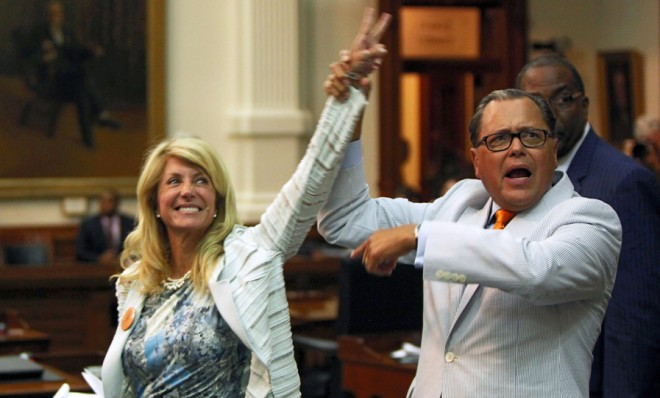Why Texas and a filibuster go together like a cold beer and a hot day
Ted Cruz and Wendy Davis aren't the only Texans to stage long filibusters. They're not even the most impressive.


Even before Sen. Ted Cruz (R-Texas) had finished his 21-hour almost-filibuster, his feat of stamina was being compared and contrasted with other recent classics of the genre: The 13-hour filibuster by his Senate colleague Rand Paul (R-Ky.) and the 11-hour tour de force by Texas State Sen. Wendy Davis (D).
While there are lots of differences between these long, mostly solo speeches, there is one glaring similarity: Cruz, Paul, and Davis all grew up in Texas — Cruz and Paul in the Houston area, Davis in Fort Worth. And while everyone remembers former Sen. Strom Thurmond's (Dixiecrat, S.C.) infamous 1957 filibuster of the Civil Rights Act — at 24 hours and 18 minutes, it still holds the record in the U.S. Senate — the actual record for longest filibuster is held by another Texan, Bill Meier.
In 1977, from 3:20 p.m. on May 2 until 10:20 a.m. on May 4, Meier held the floor in the Texas State Senate to filibuster a worker's compensation bill. In case you don't want to do the math, "Meier spoke for forty-three friggin' hours," says Joe Concha at Mediaite. Like baseball's Cal Ripken, Meier "owns one of the few records in professional or political sports that cannot and will not be broken."
The Week
Escape your echo chamber. Get the facts behind the news, plus analysis from multiple perspectives.

Sign up for The Week's Free Newsletters
From our morning news briefing to a weekly Good News Newsletter, get the best of The Week delivered directly to your inbox.
From our morning news briefing to a weekly Good News Newsletter, get the best of The Week delivered directly to your inbox.
So what is it about Texans that makes them such masters of the filibuster?
I'm not a native Texan, though I married into a family full or them and have lived in the Lone Star State for a handful of years. I'd distill the spirit of Texas down to one phrase: "No excuse, just produce."
Another way of putting that: Texans are stubborn, and they understand that in order to succeed you need to be prepared. Nobody is going to filibuster your bill for you. Brené Brown — a fifth-generation Texan, professor of social work at the University of Houston, and TED-celebrity author on vulnerability — had this to say about her people, to Texas Monthly:
When I feel vulnerable, my first reaction is to punch somebody in the face. But growing up being a Texan is also the source of my resilience. I'm very resolute in my work and very passionate. And bullheaded! So those Texas virtues don't have to be tossed out the window? No.... Self-reliance and bootstrapping are Texas virtues, but so is moral courage. And I think vulnerability is the hardest courage. To show up and let yourself be seen, to speak out, to stand up for something you believe in, that takes a lot of vulnerability in this culture. [Texas Monthly]
There's a joke in David Byrne's classic movie about Texas, True Stories:
A free daily email with the biggest news stories of the day – and the best features from TheWeek.com
Texas can seem like an exaggerated microcosm of America: Hard work, rugged individualism, pride of place, and an admiration for big things. The filibuster reflects some of those same qualities. With nothing but will and preparation, a lone individual can gum up the works of the nation's highest legislative body.
Here's a more concrete example of why Texas and the filibuster go together like a cold beer and a hot day: "Hands on a hardbody." Each year from 1992 until 2005, a Longview, Texas, Nissan dealer gave a free pickup truck to the contestant who kept upright with his or her gloved hand on the vehicle for the longest period of time. The 1995 contest — memorialized in the oddly compelling 1997 documentary Hands on a Hard Body, and the short-run Broadway musical based on that film — lasted 77 hours. In the inaugural competition, a man stood for 87 hours to get his truck.
In the trailer for the documentary, the contestants could be talking about preparing for a filibuster:
Texas.
Peter has worked as a news and culture writer and editor at The Week since the site's launch in 2008. He covers politics, world affairs, religion and cultural currents. His journalism career began as a copy editor at a financial newswire and has included editorial positions at The New York Times Magazine, Facts on File, and Oregon State University.
-
 Ultimate pasta alla Norma
Ultimate pasta alla NormaThe Week Recommends White miso and eggplant enrich the flavour of this classic pasta dish
-
 Death in Minneapolis: a shooting dividing the US
Death in Minneapolis: a shooting dividing the USIn the Spotlight Federal response to Renee Good’s shooting suggest priority is ‘vilifying Trump’s perceived enemies rather than informing the public’
-
 5 hilariously chilling cartoons about Trump’s plan to invade Greenland
5 hilariously chilling cartoons about Trump’s plan to invade GreenlandCartoons Artists take on misdirection, the need for Greenland, and more
-
 The billionaires’ wealth tax: a catastrophe for California?
The billionaires’ wealth tax: a catastrophe for California?Talking Point Peter Thiel and Larry Page preparing to change state residency
-
 Bari Weiss’ ‘60 Minutes’ scandal is about more than one report
Bari Weiss’ ‘60 Minutes’ scandal is about more than one reportIN THE SPOTLIGHT By blocking an approved segment on a controversial prison holding US deportees in El Salvador, the editor-in-chief of CBS News has become the main story
-
 Has Zohran Mamdani shown the Democrats how to win again?
Has Zohran Mamdani shown the Democrats how to win again?Today’s Big Question New York City mayoral election touted as victory for left-wing populists but moderate centrist wins elsewhere present more complex path for Democratic Party
-
 Millions turn out for anti-Trump ‘No Kings’ rallies
Millions turn out for anti-Trump ‘No Kings’ ralliesSpeed Read An estimated 7 million people participated, 2 million more than at the first ‘No Kings’ protest in June
-
 Ghislaine Maxwell: angling for a Trump pardon
Ghislaine Maxwell: angling for a Trump pardonTalking Point Convicted sex trafficker's testimony could shed new light on president's links to Jeffrey Epstein
-
 The last words and final moments of 40 presidents
The last words and final moments of 40 presidentsThe Explainer Some are eloquent quotes worthy of the holders of the highest office in the nation, and others... aren't
-
 The JFK files: the truth at last?
The JFK files: the truth at last?In The Spotlight More than 64,000 previously classified documents relating the 1963 assassination of John F. Kennedy have been released by the Trump administration
-
 'Seriously, not literally': how should the world take Donald Trump?
'Seriously, not literally': how should the world take Donald Trump?Today's big question White House rhetoric and reality look likely to become increasingly blurred
